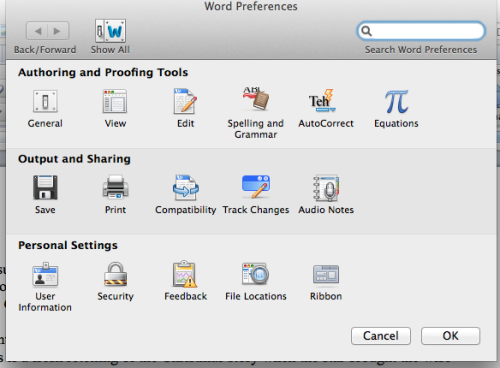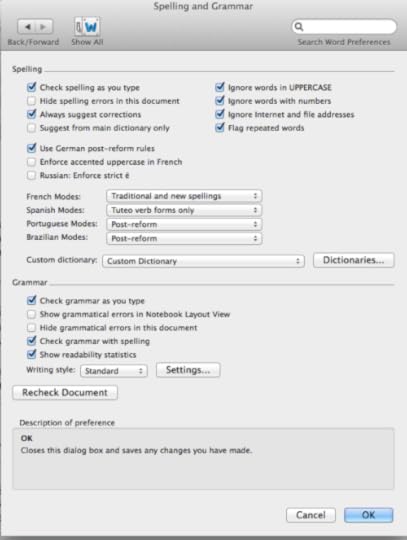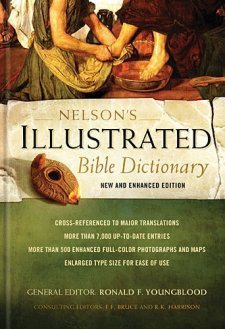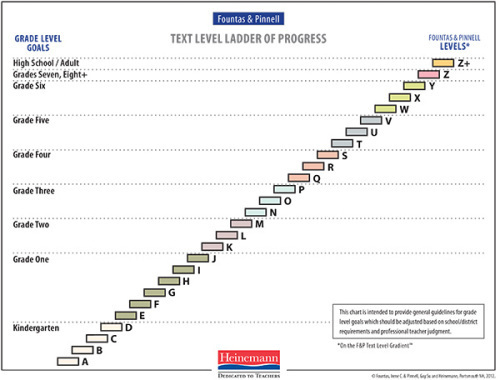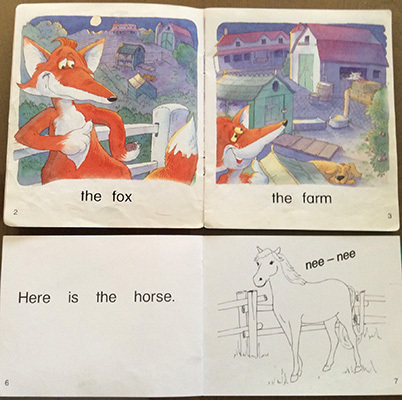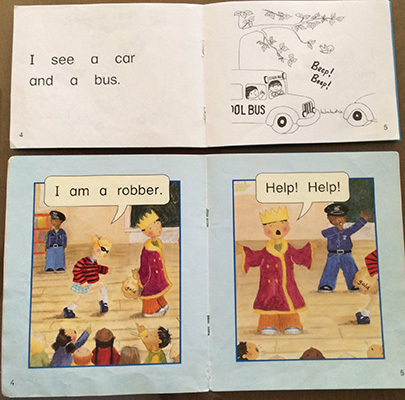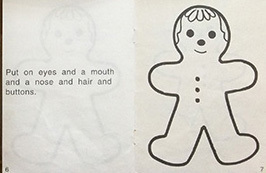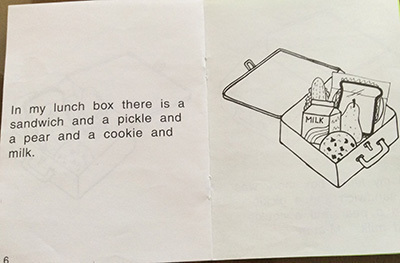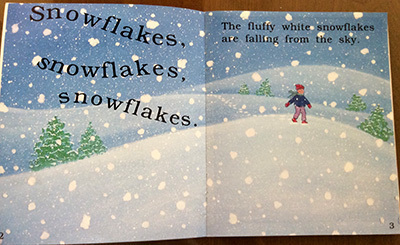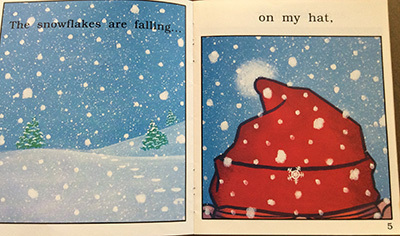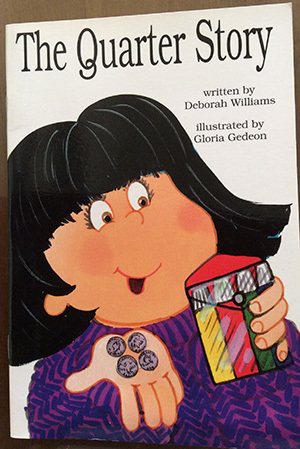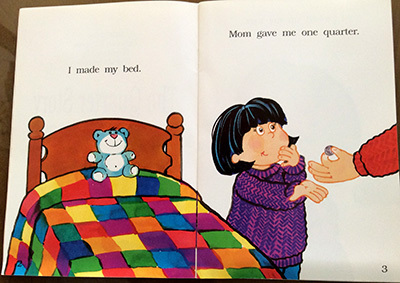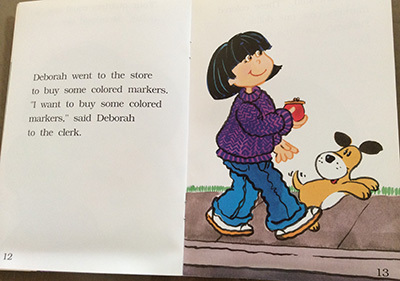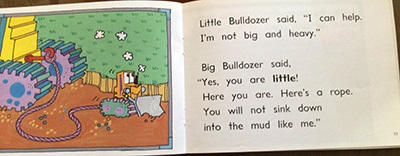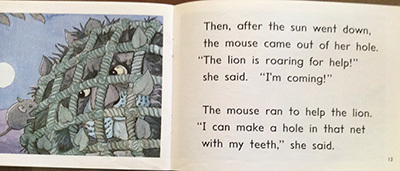Nancy I. Sanders's Blog, page 54
October 24, 2014
Flesch-Kincaid Readability Score
A tool that many authors use comes built in with Microsoft Word and gives you the Readability Statistics of your text. If you highlight a portion of text and run the spellcheck feature, after it is done checking the spelling, a small box pops up listing the Readability Statistics. Under Readability, it lists the Flesch Reading Ease and the Flesch-Kincaid Grade Level. Basically, this shows the reading level of that portion of text. For instance, if it scores a 6.2 on the Flesch-Kincaid Grade Level, students reading at grade level in the second month of sixth grade should be able to read it successfully.
Just a word of caution when using the Flesch-Kincaid Grade Level: It should not be your definitive measuring tool when working with reading levels in the elementary grades. It does not work entirely accurately when analyzing very short sentences, as most sentences are that can be found in the earliest beginning readers. Even though I will use this tool as a reference, especially when evaluating long portions of text for the intermediate or high school leveled readers, I refer mainly to the Children’s Writer’s Word Book when writing beginning readers and chapter books for elementary students.
-excerpt from Yes! You Can Learn How to Write Beginning Readers and Chapter Books, pages 47-48
And an extra note:
If you run your spellcheck and the Readability Statistics box does NOT show up after it is done, you need to change your preferences.
With your document open in Word,
On your top toolbar, click on “Word”
From the dropbox, click on “Preferences.”
This window pops open:
Under Authoring and Proofing Tools, click on SPELLING AND GRAMMAR.
Another window pops open:
Be sure you have a check mark under GRAMMAR next to:
SHOW READABILITY STATISTICS.
Filed under: Uncategorized








October 23, 2014
Book Review: Nelson’s Illustrated Bible Dictionary
Nelson’s Illustrated Bible Dictionary: New and Enhanced Edition
General Editor: Ronald F. Youngblood
The Nelson’s Illustrated Bible Dictionary: New and Enhanced Edition (NIBD) is a one-volume A to Z dictionary of words and terms found in the Bible. Full color photographs are scattered throughout of Bible-land scenes, archaeological discoveries, and models of ancient cities or biblical items. Nine maps and a map-index conclude the volume.
Some of the features I appreciate in the NIBD include:
* Five Steps To Better Bible Study Using the NIBD. This is an amazing section in the front that shows us how to use the NIBD to understand a Bible passage in a much more thorough way. Great tool for digging deeper into the Scriptures.
* Visual Survey of the Bible: Amazing charts and timelines show visually how the books of the Bible are related with each other, with people in the Bible, with eras of history, and with God’s eternal plan of redemption through Jesus.
* Pronunciation guide: I am currently writing scripts for biblical characters for our church and find this invaluable, especially since the director of the event asked me how to pronounce some of the names and I wasn’t sure until I looked them up here.
* Definition of biblical names: I wish I had this when I was writing a manuscript last month that required this. I had to look this up in different sources and it was so tedious. Now I have this handy in the NIBD for the next time this happens.
As a writer, this Bible dictionary is very helpful. It provides solid and reliable references to my research on the Bible and Bible times. As someone who likes to read and study the Bible each day, this dictionary is a ready resource that helps answer questions I have about the different books of the Bible as well as historical context of the passages I’m reading. As a person who serves in ministry at our church, this Bible dictionary is very handy to use for digging up details that help prepare faith-based activities for families or seasonal events such as a live nativity at Christmas. This is also a reliable resource for students in homeschooling families or Christian schools to use when writing school reports or working on various projects.
Of course, you can’t get as thorough of details in a one-volume reference as you could in a multi-volume Bible encyclopedia, but the entries in this book give a succint overview and basic understanding of each topic. The cross-references seem very thorough and many definitions are supported with a reference to Scripture (such as the entry: SIN) so that the reader can look up what the Bible says.
The approach this dictionary takes is non-denominational in that it tries not to support one church’s doctrine over another. In general, most topics are explained using the Bible as the source for the definitions. On some topics that various denominations differ on, (such as the entry: THE MILLENNIUM) the NIBD is careful to point out that there are several different positions regarding that issue as well as briefly explains each one.
The NIDB has useful groupings of general topics such as ANIMALS OF THE BIBLE, OCCUPATIONS AND TRADES, and PLANTS OF THE BIBLE. I like how in the section on WEIGHTS/MEASURES OF THE BIBLE, it compares the measurements to modern standards as well as lists the different word it’s referred to in different versions of the Bible.
The abundance of archaeological photographs and textual evidence makes this a good tool for high school and college students (and adults!) to use to defend their faith. This information shows our faith is based on facts and actual historical events, not just a fairy tale or myth.
-Thanks, BookLook Bloggers for another wonderful free book in exchange for my honest review!
Filed under: Book Review








Writing Opportunity: Chapter Books
Remember when I ordered two sample chapter books from Kaeden Books?
That was just 10 days ago and my books arrived at my front door yesterday! They were very prompt to send them to me.
I don’t know why, but somehow it also made me feel good just to know they’re a real place with real products and real people.
Now that I’ve got those two chapter books in my hand, I’m going to start typing them into my computer.
I might end up typing up the whole things.
Why?
For one thing, doing this trains your brain to write at this level just as riding a bike with training wheels trains your brain to learn to ride a bike.
For another thing, I like to evaluate various key elements of a published book I’m using for my mentor text. It’s so much easier to accomplish this by having it in a word document where I can search and find, run a Flesch-Kincaid readability check on various portions, and check word counts on specific pages without having to count them by hand.
I recommend you do the same as we continue in upcoming posts with the nonfiction submission we’re preparing. Whether you’re just looking at the GOOGLE PREVIEWS of chapter books Kaeden has, or you’ve ordered in your own titles to really dig into, go ahead and start typing some of these puppies into your computer.
It’s a great exercise for any genre you’re working with!
Filed under: Beginning Readers, Chapter Books








October 22, 2014
Writing Opportunity: Your Mentor Text
Today I was clicking on Kaeden’s list of nonfiction books when I discovered that their book, THE BIRD FEEDER, has the entire story available for viewing if you click on GOOGLE PREVIEW.
We can actually see how the story is laid out, line by line and page by page from beginning to end! This is really helpful because this is the first time I’ve seen how the twist at the end actually takes place.
So after I read through this, I typed out the book, line by line EXACTLY how it appears. For example, here is what my typed document looks like:
The Bird Feeder
Written by Mia Coulton
Copyright © 2014
Table of Contents
Blue Bird…4
Red Birds…6
Black Birds…8
Brown Birds…10
Yellow Birds…12
Squirrel…14
Glossary…15
Index…16
Page 4 Blue Bird
One blue bird is
on the bird feeder.
Page 5
Male and female Blue
Jays are the same color.
Acorns are their favorite
food.
I’ve decided to use THE BIRD FEEDER as my mentor text for writing and submitting my own story to Kaeden Books. If you want to write a nonfiction title at this level, you can use it, too!
For starters, just focus on the main nonfiction story (not the nonfiction facts).
For example, the main nonfiction story in The Bird Feeder is:
One blue bird is
on the bird feeder.
Two red birds are
on the bird feeder.
Be sure to keep the word count in each sentence of your story the same as your mentor text.
Be sure to keep the repetition of words in your story similar as your mentor text.
Be sure to keep the page count in your story the same as your mentor text.
Be sure to add a twist at the end of your story similar to your mentor text.
So go ahead. Just type out your own story idea that you came up with from the last post I did on brainstorming ideas.
Be sure to type it up exactly how your mentor text does.
We’ll talk about what to do next in an upcoming post.
Filed under: Beginning Readers








October 21, 2014
Writer’s Workshop Today: 3 Free Tools in Your Writer’s Toolbox
Join me today, writer friends, at the Working Writer’s Club where I’ll be teaching a telephone workshop that gives an introduction to the benefits and the basics of using 3 free tools for writers that I absolutely love:
CREATESPACE is an awesome place you can publish your book for FREE. Yes, free, and I’ve used it for about half a dozen of my self-published books.
INKSCAPE is a fantastic drawing tool you can use to create promotional materials for your books such as bookmarks and teacher’s guides and supplemental material such as read-aloud plays. And it’s FREE to use.
TEACHERSPAYTEACHERS is an amazing site where you can sell promotional and educational material for your books for teachers to use in classrooms whether they teach kindergarten through adults whether in public school, private school, or homeschooling families. They have a free membership you can join if you’re a teacher. If you’re not a teacher you can contact them and inquire about how you can join for free.
CLICK HERE for more information and to register to join the class live (or to download the recorded audio after the class is over).
And to read my current article in the Writing for Children column at the Working Writer’s Club, CLICK HERE to learn more about tools in your writer’s toolbox!
Filed under: Writer Workshops, Writing Skills, Writing Tips








October 16, 2014
Writing Opportunity: Brainstorm Ideas for New Nonfiction
Put on your Sherlock Holmes hat because we’re doing more detective work today!
Let’s brainstorm unique nonfiction ideas for you to write about to submit to Kaeden Books.
First, get out your list of 40 Nonfiction titles that Kaeden already publishes.
This list tells you what they DON’T need.
Now compare this to a list of topics that teachers teach in kindergarten through second grade. Where can you find this kind of a list?
There are various places to look. You can look at the Common Core standards for literature and math at these grade levels.
You can look at the State and National standards for science and social studies at these grade levels.
You can also take a shortcut, like I often do, and just look at teacher books for these grade levels. Look at their table of contents to see what topics they cover. These topics would make great titles for manuscript submissions to Kaeden. Look for topics in these teacher books that aren’t on Kaeden’s list of 40 nonfiction titles.
Here are 3 of my own books that I wrote for Scholastic Teaching Resources that you can use as a handy reference for this. Just click on the link, then find the table of contents in their LOOK INSIDE the book feature. Print out the table of contents for each of the following books as a handy brainstorming reference. Write down 5-10 topics you find in these books that aren’t yet published by Kaeden.
Cut & Paste Mini-Books: Science
Cut & Paste Mini-Books: Around the Year
Cut & Paste Mini-Books: Science
Filed under: Beginning Readers, Nonfiction








October 15, 2014
Writing Opportunity: Unique Nonfiction
This morning I did some detective work.
Now that we’re going to take a look at the unique nonfiction Kaeden Books is looking for right now in their submissions guidelines, I went to their website and clicked on some links.
I clicked on their link of nonfiction titles.
Then I clicked to view the page in sortable lists.
Then I clicked at the top to sort this list by grade level.
I printed out this list and put it in a file folder labeled NONFICTION TITLES.
Next I clicked on their list of nonfiction collections.
Then I clicked to view this page in sortable lists.
Then I clicked at the top to sort this list by grade level.
Then I printed out this list and put it in my file folder of NONFICTION TITLES.
Then I started clicking on GOOGLE PREVIEW of some of the books.
And I made a discovery.
The books in their list of COLLECTIONS are published by different publishers. The collections Kaeden sells are titles that are carefully selected from other publishers that are all at the same reading level.
So what does this mean?
This means that we want to FOCUS our attention on the Kaeden’s list of nonfiction titles and try to submit a title that fits in their product line.
We can use the list of their collections to help us brainstorm ideas for new titles.
One more bit of detective work to do today is to download Kaeden’s catalog. Click on the link to download the pdf file. Then spend time exploring their current catalog.
Have fun!
Filed under: Beginning Readers, Nonfiction








October 13, 2014
Guest Post: Tina Cho on Guided Reading Levels and the Writer

Tina M. Cho
Blog: Tina’s Tidbits
Facebook: Tina Wheatcraft Cho
My dear friend, former critique buddy, and AWESOME writer, Tina Cho, has put together an amazing resource for all of us to use while we’re moving forward on our journey to submit to Kaeden Books. (Thanks so much, Tina!)
GUIDED READING LEVELS AND THE WRITER
by Tina M. Cho
In the early 1990s two professors, Irene Fountas and Gay Su Pinnell, used their experiences as classroom teachers, professors, and their work with Reading Recovery (a one-to-one reading intervention program) to team together and create a way to level books for readers. Their system called Fountas and Pinnell for guided reading matches leveled books to readers.
I was teaching kindergarten in Iowa during this time and took many of these guided reading classes and read Fountas and Pinnell’s first book, Guided Reading: Good First Teaching for All Students. I even heard Gay Su speak at a conference. From then on, this is how we taught small groups for reading, using the F&P system.
Since then Fountas and Pinnell have refined their system and have written more books and assessments to help teachers teach reading. Publishers have added the F&P levels to their books.
So what does this system have to do with you as a writer for an educational publisher? Well, you should become familiar with the F&P levels so that when you write for a specific level, you know what the reader can do. So let me try to briefly explain this system.
The F & P system is leveled A-Z, with A being the first level and Z ending in high school grades. Take a look at this text gradient. A student entering kindergarten will work through four levels.
Level A: one line of text, very easy for young children with illustrations helping kids figure out the words, repetitive, big print and big spacing between words. Look at these examples.
The first book is from The Hungry Fox, which consists of only 12 words! This also has repetitive text with only TWO words on each page, but it still tells a complete story thanks to the illustrations! “The fox, the farm, the dog, the henhouse…” The second book is called The Farm, and the pages repeat. “Here is the pig. Oink oink. Here is the cow. Moo-moooo.” And so forth. The children learn the sight word “here.” The words pig, cow, and horse can be determined from the illustrations. The last page of these guided readers usually has a surprise or a twist ending.
Level B: more lines of text, slightly greater range of frequently used vocabulary, some repetition but not always. See these examples. The second book only has 23 words.
Level C: longer than B books, 2-5 lines of text on a page, more story carried by the text than the illustrations, full range of punctuation, sentences are a little longer, more variation in language patterns.
An example from the book Wake Up, Dad:
James said,
“Wake up, Dad.”
“I am asleep,” said Dad.
And here’s a sample from Gingerbread Girl, which only has 44 words, but you can see how the word count is increasing in each level.
Level D: slightly more complex story line, supportive illustrations, 2-6 lines of text, longer sentences, inflectional endings are used –ing, ed, s
In this book Lunch Box, there are 89 words.
And you’ll be pleased to know, I have this guided reading book from KAEDEN, our target publisher. This book Snowflakes, (F&P level D) has 54 words and 11 pages of text. This boy tells all the places snowflakes fall on him.
Level E: 3-8 lines of text per page, more complex stories, ideas might require more interpretation, text carries the story line, problem solving needed to figure out new words, longer words, inflectional endings used, some concepts may be less familiar to kids.
I have another book from KAEDEN for this level! The Quarter Story has 99 words. In this story the girl does various chores to earn a quarter. Once she has four quarters she goes to the store where she figures out that her four quarters are the same as $1.
Level F: 3-8 lines of text, longer stories than level E, “story lines include more episodes (actions or events), which follow one another chronologically, and some characters are more fully developed. Generally the text has a distinct beginning, middle, and end. Dialogue has appeared at earlier levels, but at this level there is greater variety in the way it is signaled and presented. Punctuation supports phrasing and meaning.” (Fountas and Pinnell, Guided Reading, p. 122)
An example of Level F is Cookie’s Week. Click the link to Amazon and use their “Look Inside feature” to read some of the text.
And here’s another example of Level F, Little Bulldozer Helps Again.
Level G: 4-8 lines of text, more challenging ideas and vocabulary, longer sentences, newer content outside of children’s experiences, new vocabulary, more events in stories…
An example of Level G is The Lion and the Mouse.
Level H: more complex language and vocabulary, longer stories, literary stories, less repetition An example of Level H is Super Fly Guy.
Level I: varied, sophisticated themes, illustrations provide low support, readers must understand different points of view, memorable characters
An example of Level I is Henny Penny and Leo the Late Bloomer.
Level J: Some books at this level are beginning chapter books of 30-60 pages which may use shorter sentences and familiar vocabulary.
Examples: Danny and the Dinosaur, Henry and Mudge
Level K: This level has a variety of texts from literary picture books (10-15 lines of text per page) to easy chapter books. Some pages have only text with no pictures. “The stories have multiple episodes related to a single plot.”
Example: Nate the Great
Level L: longer chapter books, few illustrations, sophisticated language, more detail and description, challenging vocabulary, smaller text size and narrow spacing
Example: Cam Jansen
I hope these examples helped you understand more about the F&P leveling system. Which level do you think you’d be comfortable writing for? Check Kaeden’s books on that level and study them. You could even order some in to get more of a feel for the structure.
If you want to check the guided reading level of your books, I like using Scholastic’s web site. Go here and click on “book wizard.” Type in your title, and it will pull up reading levels for you. Or if you want to search a particular level, click on “search by reading A-Z level.” If you want to see more books on level G, then set the arrows “from G to G.”
WOW!!! Thank you Tina, for all your amazing and wonderful help. You rock!!!!
Filed under: Beginning Readers, Chapter Books








October 11, 2014
Book Review: Weird and Wonderful Creations
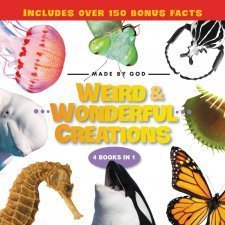
Weird & Wonderful Creations (Made by God) 4 Books in 1
by Zonderkidz
As many of you know, I have a passion for beginning readers. And I found this awesome and eye-popping beginning reader! I’m so excited to share it with you.
First of all, for all of you who know how nonfiction books for kids are near and dear to my heart, this is an amazing nonfiction book that shows kids some of the amazing plants and animals God created. I love it! God the Creator takes center stage in this hardback, full-color, 128-page oversized book bursting with stunning photographs and fun facts for kids in first and second grade to read all by themselves.
As stated on the cover, this book contains 4 beginning readers all in one place:
Spiders, Snakes, Bees, and Bats
Big Bugs, Little Bugs
Sea Creatures
Poisonous, Smelly, and Amazing Plants
Every page features at least one photograph of an up close look at interesting and unique animals and plants from all over the world. The text is chock-full of information that has high doses of kid-appeal such as “Jellyfish can be huge–120 feet long!” Along the sides on every page are tidbits of fascinating trivia such as “If the Venus flytrap catches something that isn’t food, like a rock, it will ‘spit’ it out.” And as a delightful reminder, the text reaffirms that God made them all!
Even though this book is geared for first and second graders to read on their own, I plan on reading it younger ones. There is so much to talk about on every page I know it will become a favorite in our house.
-Thanks, BookLook Bloggers for another wonderful free book in exchange for my honest review!
Filed under: Book Review








Writing Opportunity: Decisions
As I’ve been studying the , I reached a point where I had to make some decisions.
The first question I had to ask myself was:
How serious am I about submitting to them? What decision would I make?
Decision #1
I’m serious. I’m gonna do it.
(I hope you make the same decision.)
Why? For starters, because (of course) I want to write for them and earn income. But also, because even if they don’t ultimately accept my submission, I want to grow as a writer and learn from this journey.
A second question I had to ask myself was:
How much money do I want to invest into this process right now?
Decision #2
I decided to invest $25 into this journey right now.
That’s because I need to SEE their chapter books. I write chapter books for the Adventures in Odyssey Imagination Station series. But those books are 10,000 words long. Kaeden’s chapter books are much, much shorter. I’ve got to see what sentence structure they’re using, the vocabulary words they’re choosing, the paragraph length they’re using, and how they break down the chapters. I’ve got to turn pages and delve into the content to see how they pace the plot and develop their characters.
So here’s what I did:
#1. I organized the
#2. Then I purchased one book at the lowest level with one of the shortest word counts (Crow Said No). And I also purchased one book at the highest level with one of the longest word counts (Adventures of Sophie Bean: The Red Flyer Roller Coaster). With shipping and tax it added up to $22.
So while I’m waiting for these to arrive, we’re going to take a break from beginning readers and target another need they have listed on their submission guidelines:
Unique Nonfiction
(Hey all you nonfiction writer friends out there…aren’t you excited to hear this?!!!!)
Filed under: Beginning Readers, Chapter Books








Nancy I. Sanders's Blog
- Nancy I. Sanders's profile
- 76 followers


